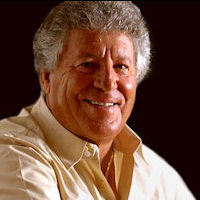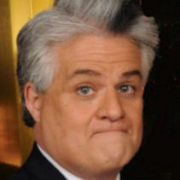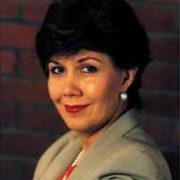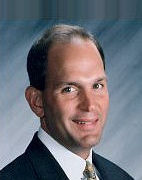Mario Andretti
Mario Gabriele Andretti is often referred to as the greatest racecar driver of all time, having proven himself a winner at all levels of competition. Mario Andretti’s skilled and versatile driving has produced some of racing history’s most legendary accomplishments. Beyond that evocative racing driver’s name, he’s been blessed with ability, determination and competitive fire to match; and during a career that spanned five decades, he has compiled an unrivaled record of accomplishment. Mario Andretti took the checkered flag 111 times during his career – a career that stretched five decades.
Mario Andretti is the only man in history to have ever won ALL of the following prestigious professional motor-sport races:
- Formula 1 World Championship
- American National Championship (four times)
- Indianapolis 500
- Daytona 500
- 24 Hours of Daytona
- 12 Hours of Sebring (three times)
- Pikes Peak International Hill Club
He has won races in sports cars, sprint cars and stock cars – on ovals, road courses, drag strips, on dirt and on pavement. He won at virtually every level of racing since he arrived in America from his native Italy at age 15.
Assessing his legacy is easy, Andretti drove the careers of three men. He drove with a passion and joy that few have equaled – and he won. He was named Driver of the Year in three different decades (the 60s, 70s, 80s), Driver of the Quarter Century (in the 90s) and Driver of the Century in January, 2000.
Mario Andretti retired from active driving at the end of 1994. Now a successful businessman off the track, he serves as spokesman, associate and friend to top executives around the world. Retirement from racing has not slowed Mario Andretti. His name is on a winery in Napa Valley, a car dealership, a chain of gas stations and a distributorship, a clothing line, a coffee table book, car washes, go-kart tracks, car care products, an IMAX movie, video games and replica cars.
Mario Andretti accepts numerous requests to speak to corporate audiences worldwide. He discusses the power of adapting to change, and shares his perspective on how life and business parallel racing. He provides insight on how individuals and companies can win, and how challenges, change, and knowledge can become key factors for success.
Full Biography
Not many have driven a race car better than Mario Andretti. He could make a bad car competitive and a competitive car victorious. He won the Indianapolis 500, the Daytona 500, the Formula One World Championship and the Pikes Peak Hillclimb. He won the Indy Car National Championship four times and was a three-time winner at Sebring. He won races in sports cars, sprint cars and stock cars – on ovals, road courses, drag strips, on dirt and on pavement. He won at virtually every level of motorsports since he arrived in America from his native Italy at age 15. He is a racing icon, considered by many to be the greatest race car driver in the history of the sport.
Assessing his legacy is easy…. He drove the careers of three men. He drove with a passion and joy that few have equaled – and he won. Mario Andretti took the checkered flag 111 times during his career – a career that stretched five decades. And he was competitive all of those years: He was named Driver of the Year in three different decades (the 60s, 70s, 80s), Driver of the Quarter Century (in the 90s) and the Associated Press named him Driver of the Century in January, 2000.
The admiration for Andretti has been for his achievements on the race track. He is in the very elite, top-superstar category of his game. Yet, if you look at his whole life, he has seen the world that most people will never see. And the journey he has made is what made him a very rich man.
The 1940s
Mario was born in Montona, Italy (now Croatia), about 35 miles from the northeastern city of Trieste. World War II broke out around the time he was born, at the beginning of 1940. When the war ended, the peninsula of Istria, which is where Montona was located, became part of Yugoslavia. So the Andrettis were inside a Communist country. The family stuck it out for three years, hoping that the only world they had ever known would right itself. In 1948, they decided to leave. Their first stop was a central dispersement camp in Udine. About a week later they were transferred to Lucca, in Tuscany.
For seven years, from 1948 to 1955, the Andrettis lived in a refugee camp in Lucca. They lived in one room with several other families – with blankets separating each one’s quarters.
Unfortunately, it was not just ‘pick up and go’. Formal requests for visas had to be submitted to the American Consulate. Only so many people got visas. And when they reached a quota, there were no more granted. And many people were trying to leave. Some were going to Argentina, some to Australia, some to Canada. Everyone followed their imagination. And some people stayed. Whatever you thought was your best bet.
The 1950s
The Andrettis waited several years for U.S. visas. When they were finally granted, the family of five left all their belongings behind and began their new life in America. On the morning of June 16, 1955, the Italian ocean liner Conte Biancamano arrived into New York Harbor. Settling in Nazareth, Pennsylvania, the family of five had $125 and didn’t speak English. Mario and his twin brother, Aldo, were 15.
In 1954, a year before arriving in the United States, the twins had gone to Monza to watch the Italian Grand Prix. They were only 14 years old, but motor racing was becoming more and more of a dream for both boys. In those days, it was more popular than any other sport in Italy. That was especially true in the 1950s, when Ferrari, Maserati and Alfa Romeo were the top players in Formula One. And the world champion at that time was Alberto Ascari – Mario’s idol.
So imagine the thrill when, a few days after arriving in America, the Andretti boys discovered a race track – right near their home in Pennsylvania. It was a half mile oval track, which was different than what they had seen in Europe. And the cars were modified stock cars, not sophisticated grand prix cars. But there was a lot of speed. And it looked very, very do-able to them. The twins were now on a mission.
To become a racer, you need your own car. And there are only three ways to obtain a car: Steal it (which was against their principles). Buy it (except they didn’t have any money). Or build it yourself (their only real option). They set out listening to anybody who had even the slightest knowledge of a race car. They found out about engines, shocks, spring rates, suspension, chassis setup, and on and on.
With some local friends they built a car – a 1948 Hudson Hornet Sportsman Stock Car –and raced it for the first time in March of 1959. Four years after arriving in America, Mario and Aldo were racing. While Aldo didn’t have the same good fortune, Mario’s career flourished as he won 20 races in the sportsman stock car class in his first two seasons.
The 1960s
Mario’s “first victory of consequence” came on March 3, 1962, a 100-lap feature TQ Midget race at Teaneck, NJ. On Labor Day in 1963, he won three midget features on the same day – one at Flemington, NJ and two at Hatfield, PA.
After joining the United States Auto Club in 1964, Mario finished third in the sprint car point standings, capped by a dramatic victory in a 100-lap race at Salem, IN. He also drove in his first Indy Car event at Trenton, NJ on April 19, 1964, starting 16th and finishing 11th in the 100-mile race, and earned $526.90 in his professional debut.
Mario won his first Indy Car race in 1965, the Hoosier Grand Prix, and finished third in the Indianapolis 500, earning him Rookie-of-the-Year honors. He went on to win his first Indy Car Championship that year – with 12 top-four finishes – and became the youngest driver (at age 25) to win that title. In 1966, he won eight Indy Car races, his first pole at the Indy 500 and a second straight national championship.
In 1967, Mario’s passion for racing saw him compete and win in the Daytona 500 stock car race, take his second pole at the Indy 500, claim his first of three career victories in the 12 Hours of Sebring endurance race, finish as runner-up in the Indy Car national championship and be named Driver of the Year for the first time.
He even tried drag racing in 1968 – driving a Ford Mustang – and earned eight more Indy Car victories en route to second place in the Indy Car point standings. Realizing a lifelong dream, Mario qualified on the pole in his very first Formula One race at the 1968 U.S. Grand Prix at Watkins Glen, but was forced out of the race with a clutch problem. But Grand Prix racing was in his blood and the decade of the Seventies would see his dream come true.
Mario’s celebrated win in the Indianapolis 500 came in 1969. He led a total of 116 laps and established 15 of 20 new records set during that event. Mario scored a total of nine wins and five pole positions that season and went on to win his third national Indy Car title. He ended the decade with a total of 30 victories and 29 poles out of 111 Indy Car starts.
The 1970s
The 1970s proved to be a decade of successful versatility for Andretti, beginning with his second victory in the 12 Hours of Sebring in 1970, followed by his first Formula One triumph in South Africa, driving for Ferrari in 1971. His mastery of endurance racing was at its zenith in 1972, when he co-drove a Ferrari 312P to victory with Jacky Ickx at the 6 Hours of Daytona, 12 Hours of Sebring, BAOC 1000 km at Brands Hatch and Watkins Glen 6 Hours.
He continued his attack on the open-wheel series, winning a total of seven Formula 5000 events in 1974 and 1975, while finishing second in points in both seasons. He also took the USAC National Dirt Track Championship title in 1974, with three wins.
Andretti returned full-time to the Grand Prix circuit in the mid-seventies. His quest for the world title began in earnest in 1976, racing for the legendary Colin Chapman at Team Lotus. Their first taste of success came in the year’s final Grand Prix in Japan, a race Andretti won in a monumental downpour. Conditions, in fact, were so bad that Niki Lauda pulled into the pits and forfeited his chance to attain the championship.
In 1977, Mario was third in the world standings with seven poles and four wins, including Grand Prix victories in his native Italy (Monza) and again in the United States (Long Beach).
The culmination of his international career came in 1978, when he won the World Championship driving for Lotus, making him the first driver in motor racing history to win the Formula One and Indy Car titles. Mario dominated the scene with nine poles and six wins in the revolutionary “ground effects” Lotus, which he had worked so hard to develop, and joined Phil Hill (1961) as the only American ever to capture the world title. He was again honored by being selected Driver of the Year, in recognition of his accomplishments.
Andretti topped the sport’s best again in 1979, taking the International Race of Champions (IROC) series. As the decade came to an end, his full-time return to Indy Cars was imminent.
The 1980s
In 1980, Mario competed for one last season with Team Lotus but was plagued by mechanical problems. He switched to the Alfa Romeo team in 1981, in what was to be his last full-time stint as a Formula One driver.
When the call came from his old friends at Ferrari to replace the injured Didier Pironi in 1982, Andretti put the car on pole at Monza and finished third, much to the delight of his Italian fans. The final Grand Prix start of his career was in the last race of the season at Las Vegas; however, a mechanical failure caused his day to end early. All told, Mario earned 12 victories and won 18 poles in a total of 128 Grand Prix starts.
As he returned to the States in the early 1980s to concentrate on Indy Car competition, Andretti teamed with his son Michael and Philippe Alliot to compete at the 24 Hours of LeMans in 1983, where they qualified and finished third, the highest finish for a non-factory team. It was also Mario’s first season with the newly-formed Newman/Haas Racing team.
The 1984 Indy Car season proved to be a memorable one for Andretti, who at age 44, won his fourth national championship by winning six events, eight pole positions and setting ten track records. The season was capped with his third Driver of the Year selection, bestowed for the first time by unanimous vote, making Mario the only man to ever win the trophy in three different decades (1969, 1978, and 1984).
As the 80s progressed, Andretti continued to make racing history with some personal milestones. With his son, Michael, they established the first-ever, father-son front row in qualifying for the 1986 Phoenix Indy Car event, a feat they accomplished a total of ten times before the close of the decade.
In 1987, in the debut of the Chevrolet-powered engine, Mario sat on the pole eight times, including his third pole at the Indy 500. He went on to lead 170 of the first 177 laps before engine failure cut his day disappointedly short.
Mario won his 50th Indy Car race at Phoenix and his 51st at Cleveland in 1988. As the decade came to a close in 1989, Andretti took on what would be the ultimate teammate – his son, Michael. It marked the first father-son team in Indy Car history.
The 1990s
With his two sons (Michael and Jeff) and his nephew (John Andretti), Mario made another “first” as the four family members competed in the same Indy Car race at Milwaukee, June 3, 1990.
The following year, the four Andrettis raced against one another for the first time in the Indianapolis 500. Jeff was voted Rookie of the Year, joining Mario (1965) and Michael (1984) as the only three members of the same family to win the award.
In 1992, Mario achieved two new milestones. He became the oldest Indy Car pole winner when he earned his record-setting 66th pole at the Michigan 500 and, at Cleveland, he set an all-time record for most Indy Car race starts with 370 (Mario finished his career with 407 starts). He was also named Driver of the Quarter Century by a vote of all former Driver of the Year winners and a panel of 12 journalists.
As he began his 35th year of professional racing in 1993, Mario continued to make headlines with his 52nd Indy Car victory at the Phoenix 200, making him the first driver to win Indy Car races in four decades and the first driver to win races in five decades. This race also marked his 111th major career victory. Records continued to be made in 1993, when Mario set a world closed-course speed record (234.275 mph) in qualifying for the Michigan 500, as he earned his 67th pole. This record stood intact until 1996, a year after the track was repaved.
Mario decided that 1994 would be his final year of competition as a Indy Car driver. The season-long farewell campaign, entitled Arrivederci, Mario featured special tributes, salutes and honors at every race venue. As he sped around a Indy Car track for the last time on October 9, 1994 at Laguna Seca Raceway, the legend of Mario Andretti assumed its place in the record books and in the hearts of his many fans.
Even though officially retired, Mario continued the next few years to seek the one major trophy missing from his mantle, the 24 Hours of LeMans. He competed an additional four times in the world’s most prestigious endurance race, winning the WSC class and finishing second overall in 1995.
Mario Today
Today Mario is a spokesman, associate and friend to top executives around the world. He works with Bridgestone Firestone, MagnaFlow, Mattel, Phillips Van Heusen, Honda and GoDaddy.
Healthy and fit, he looks as though he could slip right back into the cockpit of a race car and often does, in the two-seater which allows for a passenger to sit behind the driver and truly experience the speed and pressure that comes with open-wheel racing. Mario remains vibrant, pursuing other passions, still working at a number of personal business ventures including a winery and petroleum business. He plays tennis, enjoys waterskiing and flying his ultra-light. He was in the first Cars movie. He’s on Twitter and Facebook, carries a tablet computer and stays current in the digital era. He isn’t just any 72-year-old, any more than he was just any race car driver. He remains one of the most popular interviews in racing and the most respected voice in motorsports. He is a much sought after source by journalists from all over the world.











